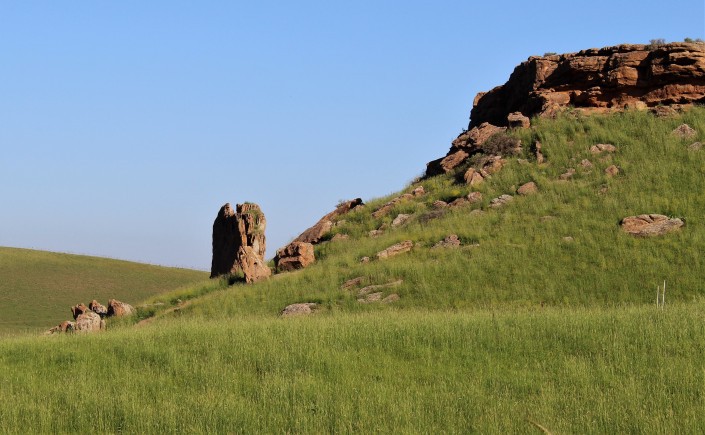ASTANA — Southern Kazakhstan attracts tourists globally who are eager to explore its blend of historical and natural wonders and visit sites believed to possess unique energy. Among these, the pilgrimage complex of Adam and Eve, also known as the Forty Disappeared Shrines, stands out as a popular destination, promising wish fulfillment and spiritual cleansing according to local beliefs. Kazinform news agency’s reporter recounted a visit to this extraordinary site.

Adam and Eve Rocks boast is not merely a mountain but the cradle of humanity. Photo credit: kazinform. Click to see the map in full size. The map is designed by The Astana Times.
Situated just 40 kilometers southwest of Shymkent, on the slopes of Mount Kazygurt, the pilgrimage complex has evolved over two decades. Now equipped with amenities such as a parking lot, cafe, souvenir shop, and a small hotel, it caters to pilgrims who extend their stay.
Upon arrival, visitors were greeted by shyrakshi, or the keepers of the site, who guided them through the rocky landscape.
“Shyrakshi (keeper) elucidates that the stones representing Adam and Eve embody the principles of masculinity and femininity, not inherently sacred but thought to bestow wishes and purify sins. Shyrakshi requests women to don headscarves and declares a prohibition on photography at the location. When I suggest that capturing good photos could help promote awareness of the site, he asserts that advertising is unnecessary for this sacred place,” wrote the Kazinform journalist.
Journey through masculinity and femininity
The pilgrimage involves a structured route, with specific rituals at various points. Men are instructed to enter the gate with their right foot first, symbolizing respect.

Kazinform news agency’s reporter attempting to cross the “armpit.” Photo credit: Kazinform
“Our journey continues on an ascending route. After covering a distance of 30 meters, we reach the initial rock, representing masculinity. The rugged surface of the steep rock is marked with holes of varying diameters. Shyrakshi suggests that these indentations signify the hardships endured by men while safeguarding their families. However, it is plausible that the holes were created by birds crafting nests in the malleable rock, with the elements of wind and rain contributing to the erosion,” wrote the Kazinform journalist.
The rocks representing masculinity and femininity hold significance, with rituals for men and women, respectively, including touching symbolic features and making requests related to marriage and motherhood.
“Shyrakshi instructs every man in attendance to place the five fingers of their right hand on small wall openings to greet their father before progressing further. Notably, women are excluded from participating in this ritual,” wrote the reporter.
Upon arrival at the female half, anticipated symbols associated with the feminine principle adorn the landscape. These symbols, once kissed, prompt girls and women to seek blessings for marriage and motherhood. For those desiring a child of a specific gender, distinct symbols on the rock signify a small bulge for a boy and a hollow for a girl.
Similar to many pilgrimage sites, Adam and Eve Rocks boast their own legends. According to one tale, this hill—drawing hundreds of daily pilgrims—is not merely a mountain but the cradle of humanity. The legend, rooted in folklore, suggests that after the great flood, Nukh-paygambar’s ark (Noah) landed at Kazygurt, releasing “a pair of each creature” onto the earth, with individual stones symbolizing this event.
“Our guide leads us onward, and we approach another rock. Shyrakshi explains that this rock represents the ship anchored at Kazygurt during the Flood. As everyone squats down, the shyrakshi recites a prayer,” wrote the Kazinform reporter.
Test for sinlessness
A unique pilgrimage feature involved navigating through rocks, either between two imposing slabs or through the armpit alike, a father-shaped rock. It is believed that individuals of any physique can navigate through the towering rocks, reaching the height of a three-story house at approximately 15 meters. The passages, at times, were as narrow as 30 centimeters. The key was leaving behind severe transgressions, engaging in virtuous deeds, and maintaining pure thoughts. According to the Kazinform reporter, those with a substantial build would effortlessly overcome the challenge if they adhered to these principles.

Photo credit: needguide.ru.
“Whether this is actually true is difficult to say. People like me, who chose not to take the easy route and instead walked through a tight passage between two rock formations resembling a sandwich, included individuals of average size. Despite facing challenges in certain spots, they managed to navigate through the rocks,” wrote the Kazinform reporter.
However, there were some people who, in the middle of the journey, began to panic, demanding to be released. Everyone who followed the alarmist had to return.
“Fortunately, our small group, which included no panickers, completed the test, and it took me about four minutes to cover the path, pausing for photos,” wrote the Kazinform reporter.
Shyrakshi said those who walked through the “armpit” underwent a purification process. Children aged 5 to 13 also had a chance to cleanse themselves by crawling through a rock with a hole known as the Mother’s Womb.
The guide further pointed out an almost smooth stone slab as the symbol of dastarkhan (set table). Nearby, symbols representing animals that descended from the ark, such as an elephant, camel, horse, and lion, were visible.
The tour concluded at a glacier with healing water. The guide explained its efficacy in treating various diseases, allowing visitors to drink the water on the spot or take some with them. As fellow travelers indulged, shyrakshi shared that he had been leading pilgrims since 1995. He said interest in these sites grew after the symbols were deciphered.
The shyrakshi emphasized the site’s uniqueness, asserting that the place remains unparalleled on Earth. The pilgrimage complex of Adam and Eve continues to captivate locals and tourists alike, drawing interest after the symbols gained recognition. Rocks and stones, long present but previously indecipherable, now hold a unique allure, making this site a one-of-a-kind destination.


